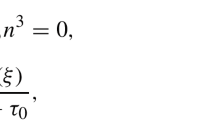Abstract
A mathematical model for traveling bands of motile and chemotactic bacteria in the presence of cell growth and death is examined. It is found that asymptotic traveling wave solutions exist in the absence of chemotaxis, due to the balance of growth, death and random motility. Thus random motility confers the ecological advantage of population propagation through migration into nutrient-rich regions. The presence of chemotaxis amplifies this advantage by moving more cells into higher nutrient concentration regions, resulting in larger and faster bands. Therefore there seem to be two types of traveling bands that can be attained by chemotactic bacteria in the presence of growth and death: (1) these growth/death/motility bands; and (2) pure chemotactic ‘Keller-Segel'-type bands. Comparison to experimental observations by Chapman in 1973 indicate that the latter seem to be formed. The relationship between these two types of solution is at present uncertain. The growth/death/motility bands may have relevance on longer time or distance scales characteristic of microbial ecological systems.
Similar content being viewed by others
Literature
Adler, J. and M. Dahl. 1967. “Method for Measuring the Motility of Bacteria and Comparing Random and Nonrandom Motility.”J. gen. Microbiol. 46, 161–173.
Barrachini, O. and J. C. Sherris. 1959. “Chemotactic Effect of Oxygen on Bacteria.”J. Path. Bact. 77, 565–574.
Chapman, P. 1973. “Chemotaxis in Bacteria.” PhD Thesis, University of Minnesota.
Chet, I. and R. Mitchell. 1976. “Ecological Aspects of Microbial Chemotactic Behavior.”Ann. Rev. Microbiol. 30, 221–239.
Holz, M. and S.-H. Chen. 1978. “Quasi-elastic Light Scattering from Migrating Chemotactic Bands ofEscherichia coli.”Biophys. J. 23, 15–31.
Keller, E. F. 1980. “Assessing the Keller-Segel Model: How Has It Fared?.”Lect. Notes Biomath. 38, 379–387.
Keller, E. F. and G. Odell. 1975. “Necessary and Sufficient Conditions for Chemotactic Bands.”Math. Biosci. 27, 309–317.
— and L. A. Segel. 1971a. “Model for Chemotaxis.”J. theor. Biol. 30, 225–234.
—. 1971b. “Traveling Bands of Chemotactic Bacteria: a Theoretical Analysis.”J. theor. Biol. 30, 235–248.
Kennedy, C. R. and R. Aris. 1980. “Traveling Waves in a Simple Population Model Involving Growth and Death.”Bull. math. Biol. 42, 397–429.
Lapidus, I. R. and R. Schiller. 1976. “Model for the Chemotactic Response of a Bacterial Populations.”Biophys. J. 16, 779–789.
—. 1978. “A Model for Traveling Bands of Chemotactic Bacteria.”Biophys. J. 22, 1–13.
Lauffenburger, D., R. Aris and K. H. Keller. 1981. “Effects of Random Motility on Growth of Bacterial Populations.”Microb. Ecol. 7, 207–227.
—— and K. H. Keller. 1982. “Effects of Cell Motility and Chemotaxis on Microbial Population Growth.”Biophys. J. 40, 209–219.
Mesibov, R., G. W. Ordal and J. Adler. 1973. “The Range of Attractant Concentrations for Bacterial Chemotaxis and the Threshold and Size of Response over the Range.”J. gen. Physiol. 62, 203–223.
Nossal, R. 1972a. “Growth and Movement of Rings of Chemotactic Bacteria.”Exp. Cell Res. 75, 138–142.
—. 1972b. “Boundary Movement of Chemotactic Bacterial Populations.”Math. Biosci. 13, 397–406.
Odell, G. and E. F. Keller. 1976. “Traveling Bands of Chemotactic Bacteria Revisited.”J. Theor. Biol. 56, 243–247.
Rosen, G. 1974. “On the Propagation Theory for Bands of Chemotactic Bacteria.”Math. Biosci. 20, 185–189.
—. 1975. “Analytical Solution to the Initial Value Problem for Traveling Bands of Chemotactic Bacteria.”J. theor. Biol. 49, 311–32.
—. 1976. “Existence and Nature of Band Solutions to Generic Chemotactic Transport Equations.”J. theor. Biol. 59, 243–246.
— and S. Baloga. 1975. “On the Stability of Steadily Propagating Bands of Chemotactic Bacteria.”Math. Biosci. 24, 273–279.
— and S. Baloga. 1976. “On the Structure of Steadily Propagating Rings of Chemotactic Bacteria.”J. Mech. Cell Motil. 3, 225–228.
Scribner, T., L. A. Segel and E. H. Rogers. 1974. “Numerical Study of Formation and Propagation of Traveling Bands of Chemotactic Bacteria.”J. theor. Biol. 46, 189–219.
Segel, L. A. 1983. “Taxes in Cellular Ecology.” (Proceedings of Meeting on Mathematics in Ecology, Trieste, Italy, 1982) (In press).Lect. Notes Biomath.
—, I. Chet and Y. Henis. 1977. “A Simple Quantitative Assay for Bacterial Motility.”J. gen. Microbiol. 98, 329–337.
Seymour, F. W. K. and R. N. Doetsch. 1973. “Chemotactic by Motile Bacteria.”J. gen. Microbiol. 78, 287–296.
Sinclair, C. G. and H. H. Topiwala. 1970. “Model for Continuous Culture which Considers the Viability Concept.”Biotech. Bioeng. 12, 1069–1079.
Author information
Authors and Affiliations
Rights and permissions
About this article
Cite this article
Lauffenburger, D., Kennedy, C.R. & Aris, R. Traveling bands of chemotactic bacteria in the context of population growth. Bltn Mathcal Biology 46, 19–40 (1984). https://doi.org/10.1007/BF02463721
Received:
Revised:
Issue Date:
DOI: https://doi.org/10.1007/BF02463721




